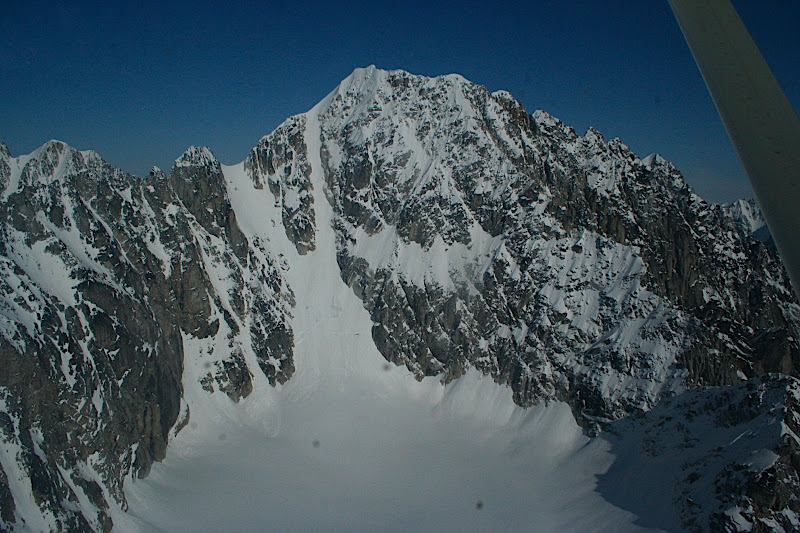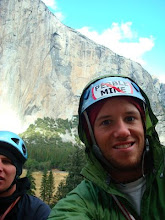The past year had been boiled down and rendered into the monumental moment before us.
Crampons clicked on, backpack straps tightened and deep breaths echoed throughout the upper fork of the Big River Glacier. Seth and I looked each other in the eyes under the pre-dawn purple sky. “Hey man, this is it” I said, eyes focused and intent. We bumped fists and he nodded. “Let's get it.”
The Revelation mountains, a sub-range located at the southwestern most portion of the Alaska Range, were first explored in 1967 by Dave Roberts, Art Davidson and friends. During their 57-day stay, they climbed a handful of beautiful peaks and named many others. Since their visit, less than twenty parties have ventured into these formidable mountains. With peaks ranging from six to almost ten-thousand feet, the Revelations are not high by altitude standards. However, their vertical reliefs are often huge and many are reminiscent of their northern brethren, the Kichatna Spires, some seventy-miles away.
Aside from the obvious positive qualities of such an untamed range, the Revelations are known to be capable of producing some of the most heinous weather imaginable. Likewise, simply getting to the mountains is exorbitantly expensive and few pilots are willing to even fly there.
This was Seth and my second trip to the Revelation mountains. Last season the two of us along with Steve Sinor made a foray into the rarely visited alpine mecca.
All of us instantly became infatuated with an unclimbed 9,250-foot peak apparently called the Ice Pyramid. We made two attempts on its prize, the southwest ridge, but turned around on the eighteenth pitch on day three when it became apparent that we were crossing a point of no return. Regardless, we left with the first ascent of a beautiful 8,385-foot peak we named the Exodus. It was however, a mere secondary consolation to the Ice Pyramid. From there on out, the Ice Pyramid filled our heads with aspirations by day and occupied our dreams at night.
 The Ice Pyramid from the northwest. The southwest ridge is on the right skyline, somewhat foreshortened and convoluted by the south spur behind it
The Ice Pyramid from the northwest. The southwest ridge is on the right skyline, somewhat foreshortened and convoluted by the south spur behind itThanks to a Mugs Stump Award we received a second chance at the peak, this time unfortunately without Steve. Seth and I flew in once again with Rob Jones of R&R Guide Services, one of the coolest guys I've ever met and definitely the air master of the range.
As we roped up on that culminating morning, Seth had that familiar expression on his face. He looked at me, but through me, his mouth slightly open and teeth biting his tongue. He was focused and concentrated, completely in the zone. Such a sight made me smile and propelled my confidence all the more. The first few pitches put us a good distance off the ground and Seth's block seemed to pass with finesse and ease. On our second attempt the year prior, we had climbed ten pitches the first day, a mere five the second and three the next before bailing. This year we aimed to climb fifteen pitches on day one and make it to a bivy we called the cave.
So far things were looking up. Pitch after pitch and hour after hour fell behind us as we cruised the known terrain. After nearly 14 hours on the go, we pulled into the cave and took to relaxing. The Alaskan sun was still high in the sky at 7 PM and even at ten it showed no signs of disappearing any time soon. The next morning we were up at four and on the go soon after.
Cave Bivy
A short, awkward move out of the cave led to one of the crux pitches of the route. Since I had led it last year, Seth took it this year just for fun. We quickly reached our previous highpoint and bypassed it by traversing under a series of gendarmes. Deep and unconsolidated snow over slab still took forever to overcome. More vertical wallowing under a massive cornice put us into the sun where conditions rapidly improved. Seth climbed a steep snow pitch to a knife edge ridge, where several long blocks of steep simul-climbing interspersed by short rock steps put us directly under the summit ridge. At a phallic looking outcrop we called the wiener rock, I belayed Seth up and then beyond. He burrowed through the cornice and hauled me up. The Ice Pyramid, an object of obsession and dedication, sacrifice and commitment was ours.
Sweat dripped into our eyes as the sun beat down upon us. A panorama of breathtaking unclimbed peaks pulled our eyes in every direction. The southwest ridge lay below like a semi-coiled snake in the ready-to-strike position. With such a beautiful day, we decided to enjoy lunch on a flatter subsidiary summit where we unroped and proceeded to walk to a flat spot overlooking the Swift glacier. Following Seth, I suddenly found myself falling. Arms and legs instinctively braced wide and in an instant I was eye level to his boots. I figured I had simply fallen into a rock moat, but quickly realized the contrary. Cold dry air blew up my face as my legs kicked into nothingness. “Shit! Seth! Oh my God! I'm in a Crevasse. Help!” He briefly stood there, not quite sure what to do. My crampons kicked into the side walls and I tediously heaved myself out. My heart rate slowed to only about 180 beats per minute and the trembling in my hands soon subsided, but the incident had left me shaken. The fact that I was unroped told me that I was very lucky to even be alive. After a while, we climbed back down the other side where we made several rappels to a small bivy platform.
A closer look into the icy gape of the crevasse
In the morning after more three rappels, I thought back to the previous year. A stuck rope high on the northwest face still resonated loudly in my head. A new thought, “Seth, we can rappel into this couloir on the southwest face and down climb the whole thing, then be off this mountain in two hours. What do ya' think?” Though tempting, it was exceedingly risky since it would put us in a different valley and the threat of rockfall was ever present. Seth cautiously took the bait and we rapped over the edge of the southwest ridge, a point of no return. Two more rappels put us on fast terrain and we down climbed the entire couloir in less than two hours. The whole time, fighter jets from Anchorage's Elmendorf Air Force base flew low over head. Needless to say, our guests kept us terrified as their near sonic booms sounded just like eminent rockfall. Both of us breathed a sigh of relief once out of the gully.
A crucial pass, one we thought Dave Roberts had taken as part of his “Butterfly Traverse” in 1967 proved to be nonexistent from the Swift side. When we got to the top of what we thought was the pass, we found only a rock wall of completely shattered shale on the other side. An attempt to traverse a shale band set off a slush avalanche that took everything over a cliff. “Shit,” I said, “what now?” Seth had that same look on his face, but this time the intense concentration seemed to be lacking. The confidence had been replaced with wariness and trepidation. “Ugh, I don't know. Let's go down and see what we see from the bottom,” he said.
We had enough food to camp out and decide in the morning when the snow was firmer, so we set up the tent and contemplated our options. It seemed as if the Ice Pyramid was playing a game with us. What had been a difficult but relatively fluid climb had become marred by an unnerving descent. “Hmmm, I wonder how many days down the river Lime Village is,” I thought. The answer...120 miles by river. “Well, I guess we'll try again tomorrow,” Seth said.
During the evening we pondered Mount Mausolus to the south, which Dave Roberts accurately described as a “hopeless labyrinth” in the 1968 American Alpine Journal. In the morning, exhausted but determined to find a way over the pass we tried again. It just didn't seem to make sense. The pass was beautiful from the Big River side, but on our side it appeared to be a 400-foot cliff. What was the deal here?
As Seth and I got to the top of the shale pinnacles, we were enveloped by a localized whiteout. “Dude...what the...” I said as I shook my head and threw my arms up. “Just let us go!” We both knew that we couldn't be more than a few pitches above our skis and that no matter where we were, the rock band was minimal. With a short clearing in the clouds we peered over and saw the glacier about 500-feet below. Several manky rappels brought us closer to salvation. At the third rappel off a dead-manned picket, 30-meters followed by a 10-to15-meter rock band was all that separated us from the glacier. “That picket is bomber,” I thought, “I hope.” Sure enough, it held and a sense of completeness filled my body as I touched ground. Seth later told divulged that the picket shifted about three inches as I went over the vertical section. He came down and then we hiked to our skis and excitedly skied back to camp in a whiteout, still feeling the mountain's pull on us.
For the rest of the trip we toured the Big River complex and scouted other options. All however, paled in comparison to the Ice Pyramid. After a few days, Seth and I decided the next best route was yet another on the Ice Pyramid, a wide gash on the west face we called the Cataclysmic Couloir. 2,500-feet of steep snow and aerated ice culminated into the northwest ridge where an icy wishbone arete loomed omnipotently above. We made good time up the couloir, climbing it in two 1,000-foot blocks followed by several pitches of belayed and simul-climbing.
The glaciated ice above looked to be AI5+/6 and with only four ice screws and a picket belay, bailing seemed the only logical option. After five picket and crappy v-thread rappels we hastily down climbed the remaining 1,700-feet. With one final look at our prize and an amazing ski back to camp, we decided to pack up and head out.
A look down the Ice Pyramid's north face from the top of the Cataclysmic Couloir
Gettin' the goods on the way back to camp
Over the next three days we scoped future objectives and relaxingly hiked 21-miles down the Big River to Rob Jones' lodge.
For us, the Ice Pyramid represented not only the culmination of a year of training and obsession. It represented a dream come true through sheer will, faith and the support of the Mugs Stump Award. The southwest ridge of the Ice Pyramid (Alaska Grade 4/5 5.8 60-degrees 2600') definitely brought out the best of both of us. Without a doubt, this was the most lay it out there, remote and consistently challenging climb we have ever done. Its ascent, as well as the descent demanded everything from us. Nothing came easy and the reward was well worth the effort. So, to Michael Kennedy and everyone else involved in the Mugs Stump Award: thank you for the opportunity to fulfill a dream! A big thanks also goes out to Black Diamond and Petzl for their support!
Here's a little press from Climbing Magazine's Hot Flashes.
